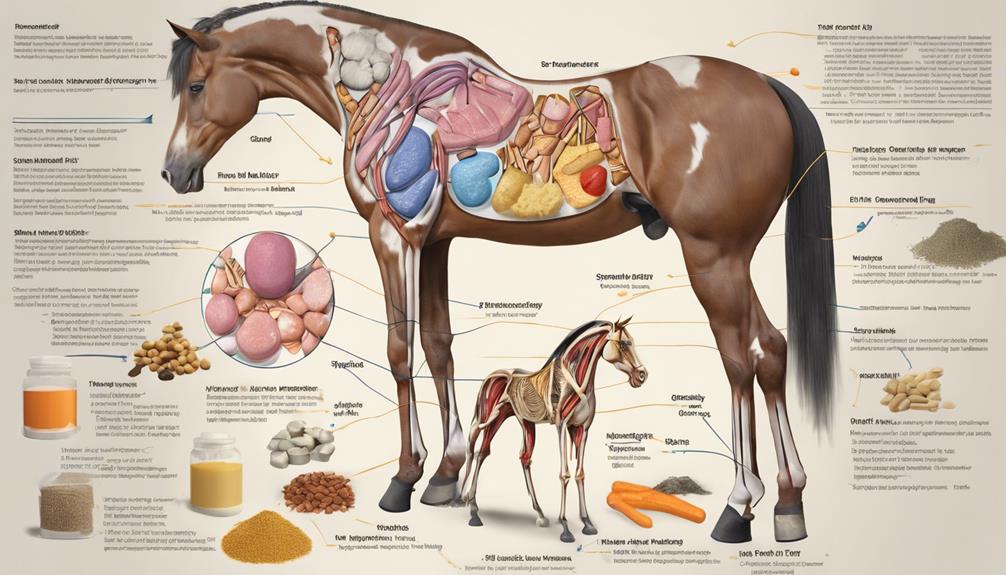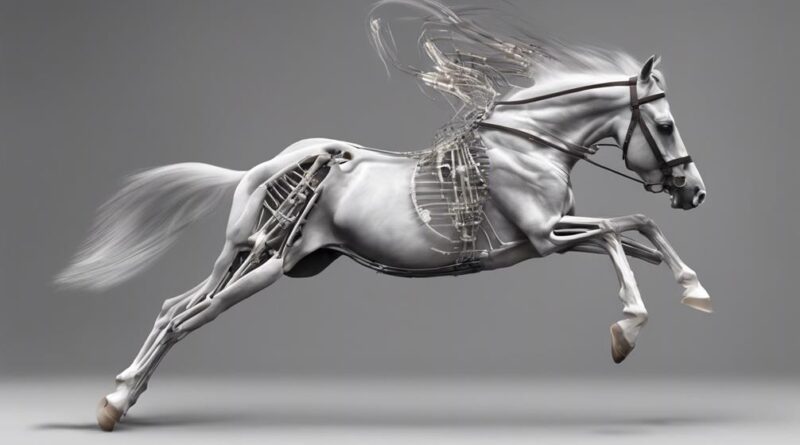7 Tips for Boosting Horse Performance With Biomechanics
Imagine your horse as a finely tuned instrument, where each movement is a note in a symphony of performance. Just like a musician perfects their craft, optimizing your horse's biomechanics can elevate their abilities to new heights.
From the way they engage their core muscles to the alignment of their limbs, every detail matters. But how can you unlock this potential and truly harness the power of biomechanics to enhance your horse's performance?
Importance of Biomechanics in Equine Performance
Understanding biomechanics is essential for maximizing your horse's performance potential. By delving into equine gait analysis, you unlock a world of benefits that can significantly enhance your horse's abilities. Equine gait analysis is a crucial aspect of biomechanics that focuses on studying how horses move and the mechanical principles governing their motion. Through this analysis, you can gain valuable insights into your horse's movement patterns, identifying any irregularities or asymmetries that may be affecting its performance.
One of the primary benefits of incorporating biomechanics into your horse's training regimen is the ability to optimize its movement efficiency. By understanding the biomechanics of how your horse moves, you can make targeted adjustments to its training, tack, or even shoeing to help improve its overall performance. This tailored approach can enhance your horse's balance, coordination, and agility, ultimately leading to better performance outcomes in various disciplines.
Moreover, equine gait analysis allows you to detect early signs of lameness or discomfort in your horse. By monitoring changes in its movement patterns over time, you can proactively address any issues before they escalate, thus preventing potential injuries and ensuring your horse's well-being. Overall, integrating biomechanics into your horse's training and care routine can have a profound impact on its performance, longevity, and overall quality of life.
Understanding Horse Movement Mechanics
To grasp the intricacies of horse movement mechanics, observe how your horse's muscles work in unison to propel its body forward with strength and grace. Understanding horse gait is crucial in assessing your horse's performance indicators. Different gaits, such as walk, trot, canter, and gallop, each have specific movement patterns and biomechanical characteristics that influence your horse's overall performance.
When analyzing your horse's gait, pay attention to performance indicators like stride length, cadence, and symmetry. A longer stride length often correlates with increased speed and efficiency, indicating better performance capabilities. Cadence, which refers to the rhythm and timing of footfalls, can indicate the coordination and balance of your horse's movements. Additionally, symmetry in movement suggests that your horse is using its body evenly on both sides, leading to optimal performance and reduced risk of injury.
Key Biomechanical Factors for Performance Enhancement
Enhance your horse's performance by focusing on key biomechanical factors. Joint flexibility and muscle strength play crucial roles in optimizing your horse's movements and overall performance. Improving these factors can lead to better agility, stamina, and power in various equestrian disciplines.
- Joint Flexibility: Ensuring your horse has good joint flexibility is essential for a full range of motion. This allows your horse to move more freely and efficiently, reducing the risk of strain or injury during training or competition.
- Muscle Strength: Developing muscle strength is vital for supporting your horse's frame and movements. Strong muscles provide stability and power, enabling your horse to perform tasks with greater ease and precision.
- Balance and Coordination: Working on your horse's balance and coordination enhances its ability to maintain equilibrium and execute maneuvers accurately. Improving these aspects can lead to smoother transitions, sharper turns, and better overall performance in various riding activities.
Implementing Biomechanical Analysis Techniques
Boost your horse's performance by incorporating biomechanical analysis techniques to optimize its movements and enhance overall capabilities. Start by conducting equipment evaluations to ensure that your horse's gear fits properly and supports its biomechanics. Additionally, consider a rider assessment to address how your own position and aids may be influencing your horse's movement patterns.
Engaging in gait analysis is crucial for understanding how your horse moves. By studying its gait patterns, you can identify any asymmetries or irregularities that may be affecting performance. This analysis allows you to tailor training programs to address specific areas of improvement and enhance overall biomechanics.
Another essential aspect is muscle activation assessment. Understanding which muscles your horse is engaging during different movements can help pinpoint areas of weakness or tension. By focusing on optimizing muscle activation patterns, you can increase your horse's strength and flexibility, leading to improved performance outcomes.
Tailoring Training Programs to Enhance Biomechanics
Craft tailored training programs to optimize your horse's biomechanics and enhance its performance potential. By customizing exercises and attending biomechanics workshops, you can take your horse's abilities to the next level.
- Customized Exercises: Design exercises that target specific areas needing improvement in your horse's biomechanics. For example, if your horse struggles with engaging its hind end, incorporate exercises like shoulder-in or leg-yields to encourage better engagement and strength in this area.
- Biomechanics Workshops: Attend workshops or clinics focused on biomechanics to deepen your understanding of how your horse moves and how to improve its performance. These workshops often provide valuable insights and practical tips on enhancing your horse's biomechanics through tailored training programs.
- Consistent Assessment: Regularly assess your horse's progress and adapt the training program as needed. Biomechanics is a dynamic field, and what works for one horse may not work for another. Keep track of your horse's development and adjust the exercises accordingly to continue optimizing its biomechanics.
Monitoring Progress Through Biomechanical Data
To track your horse's progress effectively and make informed training decisions, start monitoring its development through biomechanical data analysis. Evaluating progress through biomechanical feedback allows you to understand how your horse is responding to training and identify areas for improvement. By collecting data on key biomechanical metrics such as stride length, symmetry, and vertical movement, you can gain valuable insights into your horse's performance.
Start by establishing baseline measurements for your horse's biomechanics. This initial data will serve as a reference point for future evaluations, helping you track changes over time. Regularly assess your horse's biomechanical feedback during training sessions and competitions to monitor progress and adjust your training program accordingly.
Look for trends in the data to identify areas where your horse is excelling and areas that may need more attention. For example, if you notice an improvement in stride length but a decrease in symmetry, you can focus on exercises that promote balance and coordination. Use biomechanical feedback to fine-tune your training strategies and address any weaknesses in your horse's performance.
Integrating Nutrition for Optimal Biomechanical Support

How can you ensure that your horse's biomechanical performance is optimized through proper nutrition?
Nutrition plays a crucial role in supporting your horse's biomechanics, helping them perform at their best. By integrating specific nutrition strategies and biomechanical supplements, you can enhance your horse's overall performance and well-being.
Nutrition Strategies for Optimal Biomechanical Support:
- Balanced Diet: Ensure your horse receives a well-rounded, balanced diet tailored to their individual needs. This includes a proper mix of hay, grains, and supplements to support their muscle function and overall energy levels.
- Hydration: Adequate hydration is essential for proper muscle function and overall performance. Make sure your horse has access to clean, fresh water at all times, especially during training and competitions.
- Vitamins and Minerals: Supplement your horse's diet with essential vitamins and minerals that support bone strength, muscle function, and overall health. Consult with a veterinarian or equine nutritionist to determine the specific needs of your horse.
In addition to these nutrition strategies, incorporating biomechanical supplements can provide targeted support for your horse's joints, muscles, and overall biomechanical function. By combining proper nutrition with specialized supplements, you can help your horse achieve optimal biomechanical performance and reach their full potential.
Seeking Professional Biomechanics Consultations
For optimal guidance on improving your horse's biomechanical performance, consider seeking consultations from professional experts in the field. Professional guidance can provide valuable insights into your horse's movement patterns, muscle engagement, and overall biomechanical efficiency. By consulting with experts in biomechanics, you can gain a deeper understanding of how your horse moves and identify any areas of improvement to enhance performance.
Professional consultations in biomechanics offer a range of benefits for both you and your horse. These experts can conduct thorough assessments to evaluate your horse's gait, posture, and muscle symmetry. Through advanced analysis techniques, they can pinpoint specific issues that may be impacting your horse's performance. With this detailed information, you can work with the professionals to develop targeted training programs and corrective exercises tailored to address your horse's unique biomechanical needs.
Furthermore, biomechanics experts can help you optimize your horse's movement mechanics to prevent injuries and enhance longevity in their athletic career. By fine-tuning your horse's biomechanics, you can unlock their full potential and achieve peak performance levels. Investing in professional biomechanics consultations demonstrates your commitment to your horse's well-being and success in various equestrian disciplines. So, take the next step towards improving your horse's performance by seeking professional guidance in biomechanics.
Frequently Asked Questions
Can Biomechanics Help With Specific Issues Like Saddle Fitting or Hoof Balance in Horses?
If you're wondering about saddle fitting or hoof balance for your horse, biomechanics can be a game-changer. Equine chiropractic adjustments can help address any alignment issues, while understanding biomechanics can guide you in making the right adjustments.
Additionally, focusing on proper nutrition can complement biomechanics by ensuring your horse's body has the necessary support for optimal performance. So, yes, biomechanics can definitely assist with specific issues like saddle fitting and hoof balance in horses.
How Do Different Riding Disciplines Affect Biomechanics and Performance in Horses?
When you ride, your horse's biomechanics adapt to the demands of the discipline. Jumping techniques and dressage movements require precise coordination for optimal performance.
In contrast, barrel racing and trail riding emphasize speed and agility, impacting your horse's movement patterns differently.
Understanding these variations helps you tailor training to enhance biomechanics and overall performance, ensuring your horse excels in your chosen riding discipline.
Are There Specific Exercises or Stretches That Can Improve a Horse's Biomechanics?
To improve your horse's biomechanics, focus on equine physiology through targeted exercises. Incorporate training that enhances muscle flexibility and conditioning.
Engage in stretches and movements that promote strength and agility. By consistently working on these aspects, you can help your horse perform at its best.
How Can Biomechanics Play a Role in Preventing Injuries in Horses?
To prevent injuries in horses and promote equine wellness, biomechanics can play a crucial role. Understanding how a horse's body moves and functions can help you identify potential issues before they become serious problems.
Can Biomechanics Be Used to Assess and Improve a Horse's Mental and Emotional Well-Being?
To assess mental health and emotional balance in horses, biomechanics can play a key role. Understanding how a horse's body moves and functions can help you pinpoint any physical issues that may impact their emotional well-being.
Conclusion
So, now that you've learned about the importance of biomechanics in enhancing horse performance, make sure to implement these tips in your training program.
By understanding horse movement mechanics, focusing on key biomechanical factors, and monitoring progress through data analysis, you can optimize your horse's performance.
Don't forget to seek professional biomechanics consultations and integrate proper nutrition to support your horse's biomechanical needs.
Keep pushing boundaries and striving for peak performance!
